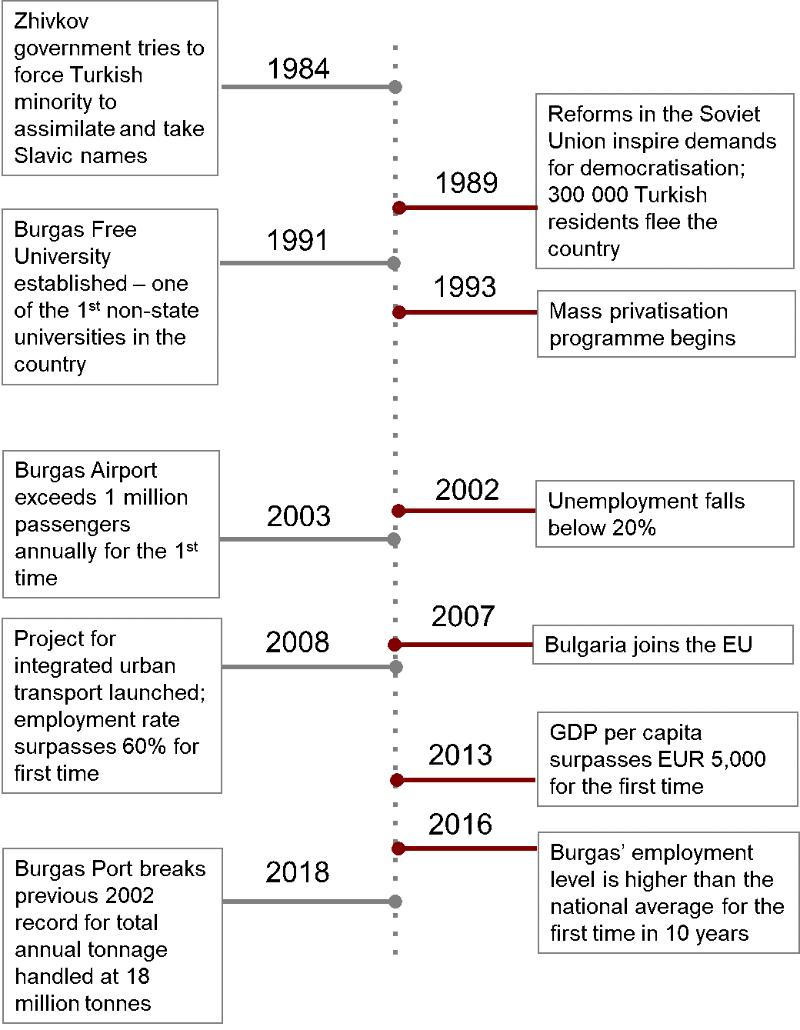By Brian Field.
The findings, interpretations and conclusions are those of the authors and do not necessarily reflect the views of the European Investment Bank.
>> Download the entire essay as eBook or PDF
Burgas, Bulgaria’s fourth largest city, has long been a nationally important industrial, transport and cultural centre. Today the country’s largest port and the centre of Bulgaria’s fishing and fish processing industries, Burgas has undergone profound changes over the past fifty years—not least due to its transition from a Soviet era in the early 1990s—and increasingly proves that it deserves to be called one of Central Europe’s smartest cities.
When the Communist Party came to power in 1944, Burgas was a prime example of a flourishing European multicultural town. However, the beginnings of socialism brought about profound changes to the city’s urban fabric. New rulers, insistent on developing heavy industry and constructing vast swathes of pre-fabricated multi-storey housing estates, damaged or destroyed much of the city’s previous heritage. This, together with a national drive for Turkish minority inhabitants to assimilate and adopt Slavic names, resulted in much of the city’s Turkish and Greek population emigrating to resettle in their home countries.
Following the fall of Communism, Burgas began to experience a new influx of primarily Bulgarian immigrants from rural areas and the surrounding smaller towns, attracted by the city’s decades-long entrepreneurial spirit and the prospect of securing higher-paid work. This meant that although the population of the city itself has stayed relatively stable at around 200,000, the population of the entire metropolitan area has grown substantially to around 300,000, putting pressure on the city’s relatively underdeveloped infrastructure. From 2001 to 2011, GDP per capita, corrected for purchasing power, more than doubled, from EUR 5,600 to EUR 11,400.
In more recent times, Burgas has garnered a reputation for its smart city vision and solutions. One of the city’s key priorities in its transition to a capitalist market economy has been to improve its mobility and infrastructure platform so that it is able to “catch up” with other Western European cities. Burgas is famously the first city in Bulgaria to entirely transform and modernise its public transport system. Sustainable mobility has been on the city’s agenda since the mid-2000s, when Burgas launched an integrated public transport plan.
Over the course of its transformation, Burgas has closely cooperated with top European cities such as London and Milan on the implementation of smart mobility solutions. It has also used EU funds to develop an integrated transport system with car-free zones, dedicated bike lanes and eco-friendly buses. Paid parking has been introduced to central areas to encourage pedestrianisation, while special mobility services for disadvantaged people, including children, the elderly and those with disabilities, have recorded an uptake of over 20,000 trips per year. As a result of these interventions and others, the share of roads deemed to be in acceptable condition has increased from less than 10% in 2006 to 42% in 2016.
Other priorities for the city in the recent period have included the rehabilitation of railway infrastructure and the promotion of energy efficiency. A recent upgrade of the Plovdiv-Burgas railway line has reduced journey times between Burgas and Sofia and has improved regional connectivity, while the city’s inclusion in schemes such as the Covenant of Mayors and the Sharing Cities Programme has encouraged the upgrading of the city’s public buildings to make them more energy efficient. JASPERS assistance and the JESSICA funding mechanism have been fundamental to the success of these initiatives.
Today, investments in infrastructure are having positive spillover effects. The economic potential of Burgas now places it second among all Bulgarian municipalities, and more than 16,000 companies operate in the city. Employment is on the rise, and in 2016 was higher than the national average for the first time in ten years. Meanwhile, GDP per capita is rising twice as fast as the national average, and passenger traffic at Burgas airport is increasing at an annual rate of over 20%.
This increase in wealth further boosts demand for infrastructure. A new ferry route from Burgas to Georgia marks the city’s ambition to become a major logistics centre at the crossroads of Southeast Europe and Western Asia, and low-cost airline Ryanair recently chose the city as its second base in Bulgaria following an investment of €80 million. This all ties into a new city plan which is designed to open up the city to the sea by designating several new residential neighbourhoods and highways.
The findings, interpretations and conclusions are those of the authors and do not necessarily reflect the views of the European Investment Bank.
